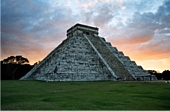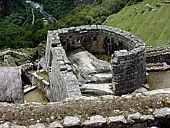Kukulcan Castle
 Temple built around the 12th century AD, by the well-known and prolific Mayan culture, which has numerous other temples and pyramids spread throughout Mexico and Central America. This temple as a whole is a sample of the advanced mathematical and astronomical knowledge of the culture, as well as the astronomical intentionality of its construction. The Mayan agricultural calendar, called Haab, consists of 365 days, the same number obtained by adding all the stairs of the pyramid, including its upper platform; On the other hand, during the equinoxes one of the most impressive effects of the pyramid occurs. At sunset on these equinoxes, the shape of a snake can be clearly seen on the sides of the NNE-oriented staircase. This snake corresponds to the mythological figure of Kukulcán or the Feathered Serpent, Mayan god equivalent to Quetzalcoatl of the Aztecs.
Temple built around the 12th century AD, by the well-known and prolific Mayan culture, which has numerous other temples and pyramids spread throughout Mexico and Central America. This temple as a whole is a sample of the advanced mathematical and astronomical knowledge of the culture, as well as the astronomical intentionality of its construction. The Mayan agricultural calendar, called Haab, consists of 365 days, the same number obtained by adding all the stairs of the pyramid, including its upper platform; On the other hand, during the equinoxes one of the most impressive effects of the pyramid occurs. At sunset on these equinoxes, the shape of a snake can be clearly seen on the sides of the NNE-oriented staircase. This snake corresponds to the mythological figure of Kukulcán or the Feathered Serpent, Mayan god equivalent to Quetzalcoatl of the Aztecs.
Macchu Picchu
 The well-known city in Peru, which dates back to 1500 AD, has also shown signs of containing architecture dedicated to astronomy. A monolithic structure called the Intihuatana has been associated with marking the summer solstices, if the longer sides of this structure are projected. Likewise, the Tower of Machu Picchu has been catalogued as an ancient observatory. Its construction is shaped like a letter "P", whose curvature is oriented towards the place where the Sun rises, while one of the windows faces the place of the winter solstice. The astronomical hypotheses at Machu Picchu are somewhat more speculative, at a level similar to that at Stonehenge.
The well-known city in Peru, which dates back to 1500 AD, has also shown signs of containing architecture dedicated to astronomy. A monolithic structure called the Intihuatana has been associated with marking the summer solstices, if the longer sides of this structure are projected. Likewise, the Tower of Machu Picchu has been catalogued as an ancient observatory. Its construction is shaped like a letter "P", whose curvature is oriented towards the place where the Sun rises, while one of the windows faces the place of the winter solstice. The astronomical hypotheses at Machu Picchu are somewhat more speculative, at a level similar to that at Stonehenge.

